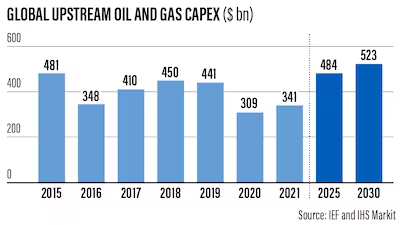Underinvestment in the hydrocarbons sector amid green transition efforts and changing government regulations could lead to higher oil prices and growing energy scarcity, according to a report by the International Energy Forum and IHS Markit.
The total investment in the upstream sector of the oil and gas sector fell 23 per cent below the pre-coronavirus levels to $341 billion in 2021 while oil demand continued to rise globally, the report said.
The upstream sector is related to the exploration and production of hydrocarbons or oil and gas.
The energy crisis in Europe and Asia this winter is a preview of what can be expected in the coming years, said Joseph McMonigle, secretary general of the forum.
“Two years in a row of large and abrupt underinvestment in oil and gas development is a recipe for higher prices and volatility later this decade,” he said.

Oil prices rose more than 40 per cent this year as global economies continued to recover from the coronavirus pandemic.
Brent, the global benchmark for two thirds of oil, was trading at $75.26 a barrel at 9.08am UAE time on Wednesday while US crude gauge West Texas Intermediate was at $71.81 a barrel.
The price of natural gas also jumped by more than 40 per cent since the start of the year to $3.79 per million British thermal units on Wednesday.
“More frequent boom-bust cycles will harm consumers and producers recovering from Covid, set back UN climate and sustainable development goals and threaten global security,” said Mr McMonigle.
The report also highlighted a number of factors that are hindering investment in the energy sector.
These include record price volatility, changing government regulations, divergent long-term demand scenarios and non-standardised environmental, social, governance criteria “that are driving up investment hurdles and hiking the cost of capital for long-cycle projects”, the report said.
International Energy Forum secretary general
Pressure on governments and industry for a green recovery is further constraining the availability of capital to invest in the oil and gas sector.
“While the energy transition proceeds, underinvesting in oil and gas before renewables and other low-carbon technologies are ready to scale up to meet energy demand could create recurrent energy crises of the kind we saw in Asia and Europe over the last few months, resulting in elevated prices and adverse economic consequences,” said Daniel Yergin, vice chairman of IHS Markit and author of The New Map: Energy, Climate and the Clash of Nations.
The global oil and gas industry requires more than $600bn of investment annually until 2030 to keep pace with the rising demand, Dr Sultan Al Jaber, UAE Minister of Industry and Advanced Technology and managing director and group chief executive of Adnoc, recently told the Abu Dhabi International Petroleum Exhibition and Conference.
Echoing his views, Suhail Al Mazrouei, UAE Minister of Energy and Infrastructure, also said a lack of investment in securing future energy supplies could extend the cycle of higher oil prices.
"If we are not investing enough, I am afraid, we could see highs like we have seen in coal and in gas due to lack of investments," Mr Al Mazrouei said at the time.
He credited the Opec+ bloc of oil exporters, of which the UAE is a part, for helping to stabilise oil prices.
Last week, JP Morgan, the largest lender in the US, also highlighted the problem and said underinvestment in the oil and gas sector over the past 18 months, caused by the pandemic, has hit the output capacity of many producer countries and their ability to respond to recovering oil demand.
It predicted that Brent will "overshoot" to $125 a barrel next year and $150 in 2023 due to the scenario.
“Oil and gas upstream investment will need to increase and be sustained at near pre-Covid levels of $525bn through 2030 to ensure market balance despite slowing demand growth,” the report by the IEF and IHS Markit said.
Meanwhile, the next two years are critical for sanctioning and allocating capital towards new projects to ensure adequate oil and gas supply comes online within the next five to six years, the report said.
The fear of a mismatch between demand and future supply could start to materialise in this time frame, the report said.
"Operators will continue to favour projects with access to existing infrastructure as these require less capital, have shorter payback periods and are more insulated from long-term demand risks," it said.
Oil demand growth is expected to be robust across Asian countries that are not part of the Organisation for Economic Co-operation and Development, as well as Africa and the Middle East in the coming years. This underscores the importance of higher investment to boost production, the report said.
A steady stream of investment is also needed to offset declines in existing oil and gasfields.
“Without additional drilling, we estimate that non-Opec production would decline by 9 million barrels per day by 2025 and 20 million bpd by 2030,” it said.





